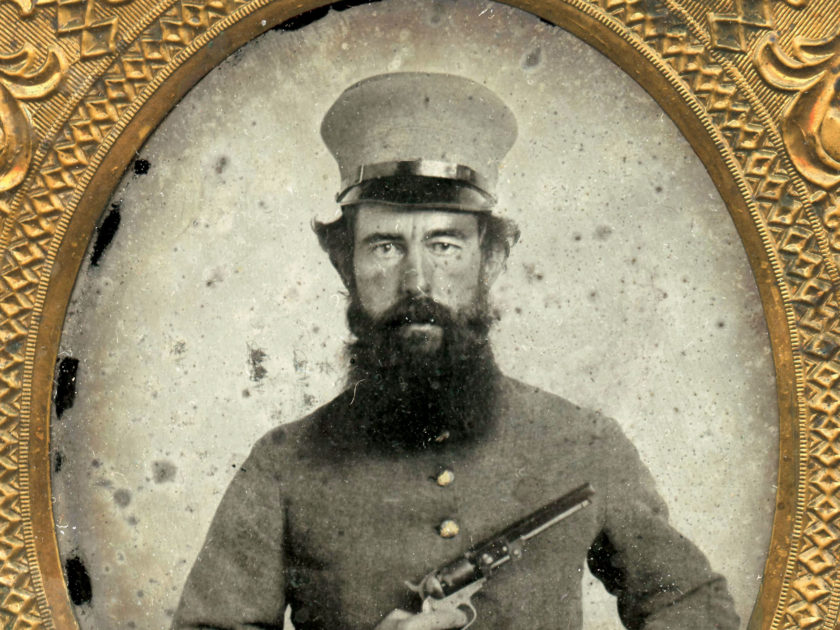Bryan Watson’s passion for collecting might be summed up in a fortune cookie he once received: “Where your treasure is there will your heart be also.”
His treasure can be found in the Civil War images he’s amassed. “Some people collect because they like the look of the inanimate object or the colors. I collect because I feel a deep down connection—almost on a spiritual level—to the people in those cased images,” Watson notes.
The first faces in cases that caught his attention appeared in Ken Burns’ The Civil War. Watson, then in his teens and living with his family in Wyoming, asked his perpetual junk-hunter parents if they had ever seen such things. His dad went down to the storage room and came back with a small box that contained civilian ambrotypes. One was a quarter-plate of an elderly couple, and inside the case was a lock of hair attached to a paper inscribed Manerva Warren. “I was blown away at how her image and name were preserved for such a long time,” Watson recalled, adding, “That civilian quarter-plate started it all.”
In 1992, Watson purchased his first soldier image, a sixth-plate tintype. In the beginning, during the pre- and early-digital age, living in Wyoming made collecting almost impossible. Shows weren’t really an option, and so he relied on printed catalogs. But they took a while to land in his mailbox, and most of the images he wanted were already gone by the time he called. For some time he purchased images sight unseen from dealer Dave Taylor.
The internet changed his life. “My collecting really spiked as I was finally on a level playing field with people back East,” he observes, and adds with a laugh, “The internet is the cause of my collecting insanity.”
Watson is also a dealer, offering a variety of photographs on civilwarimage.com. His collecting philosophy is simple. “If I like the look of the image, I go after it. There are lots of great images out there, but if it doesn’t speak to me, I usually don’t buy it. … The one thing I learned as a collector was to buy the best even if you have to pay a premium. Like most collectibles, the best stuff always maintains its value.”
Here’s a selection of his keepers.

Sporting a cap with decidedly Mexican War flair, and pressing a Colt Model 1849 revolver against his chest, this Confederate reminds Watson of the prototypical Southern soldier. He adds, “This is my favorite image in the whole collection. It isn’t in perfect condition, but I kept all the original pieces and didn’t spruce it up with a nicer case. I got this out of Tennessee and I believe that is where he served.”

The uniform worn by this soldier has all the hallmarks of those issued to Georgia volunteers in the autumn of 1861. His Model 1816/1822 musket, converted from flintlock to percussion, reinforces his early war appearance.
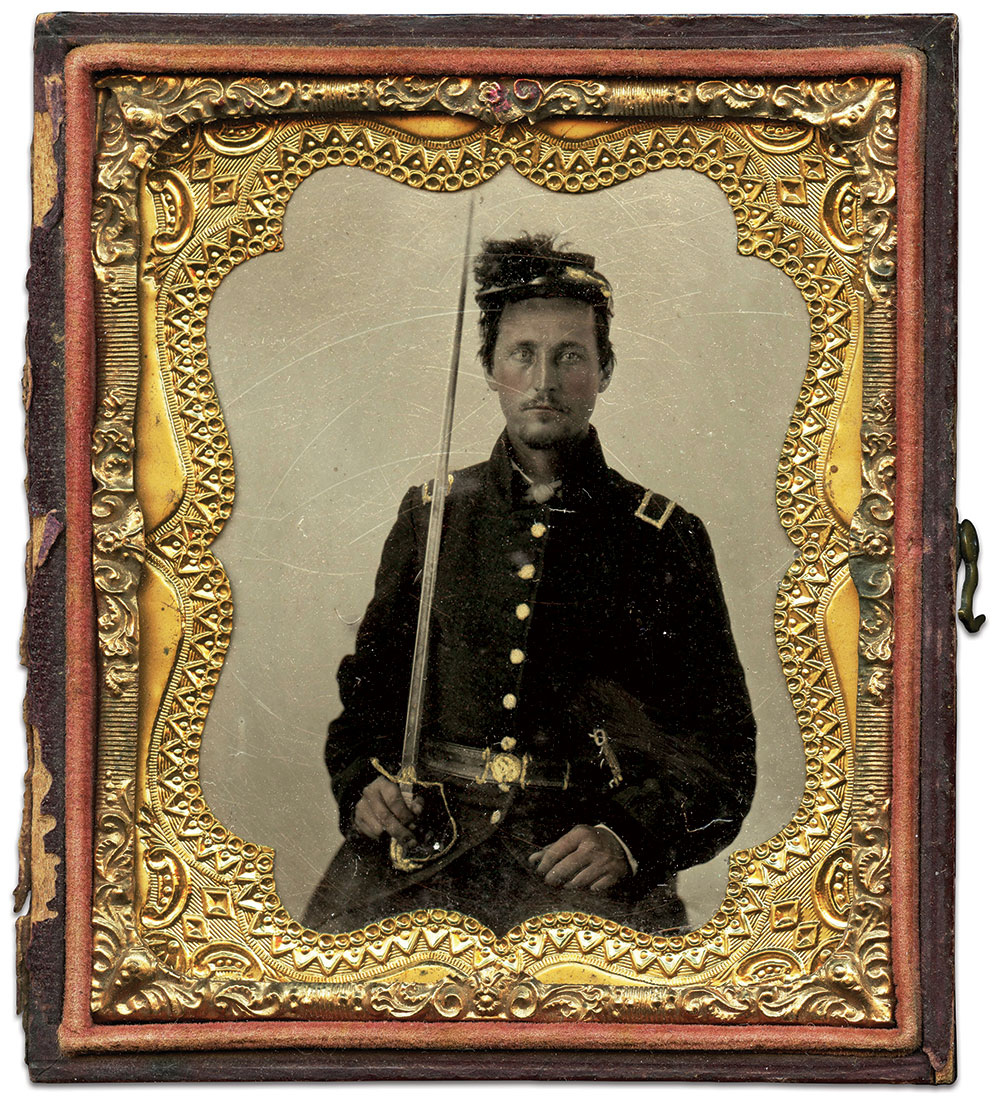
An antebellum militia sword, perhaps a family heirloom, is held by this second lieutenant believed to be an early war Georgian. He likely sat for this portrait in 1860 or early 1861, based upon the style of his uniform. The top of the scabbard for the sword is visible. The low crown cap and black plume is worthy of note.

The shoulder pads on the dark frock of this soldier were worn by numerous militia companies prior to and during the early days of the war. Uniforms authority and MI Senior Editor Ron Field notes, “Their period name was ‘puff wings,’ and they usually also included a strap buttoned at the base of the neck, similar to more orthodox epaulets. They also usually had fringe-like epaulets. I would suggest that what is represented in this image is a modified version of ‘puff wings.’”
The soldier also wears a patent leather waist belt secured by what appears to be a federal breastplate. The coat and belt, along with his cap and medium color pants made of coarse material, suggest Southern origins. Watson believes him to be a Virginian.
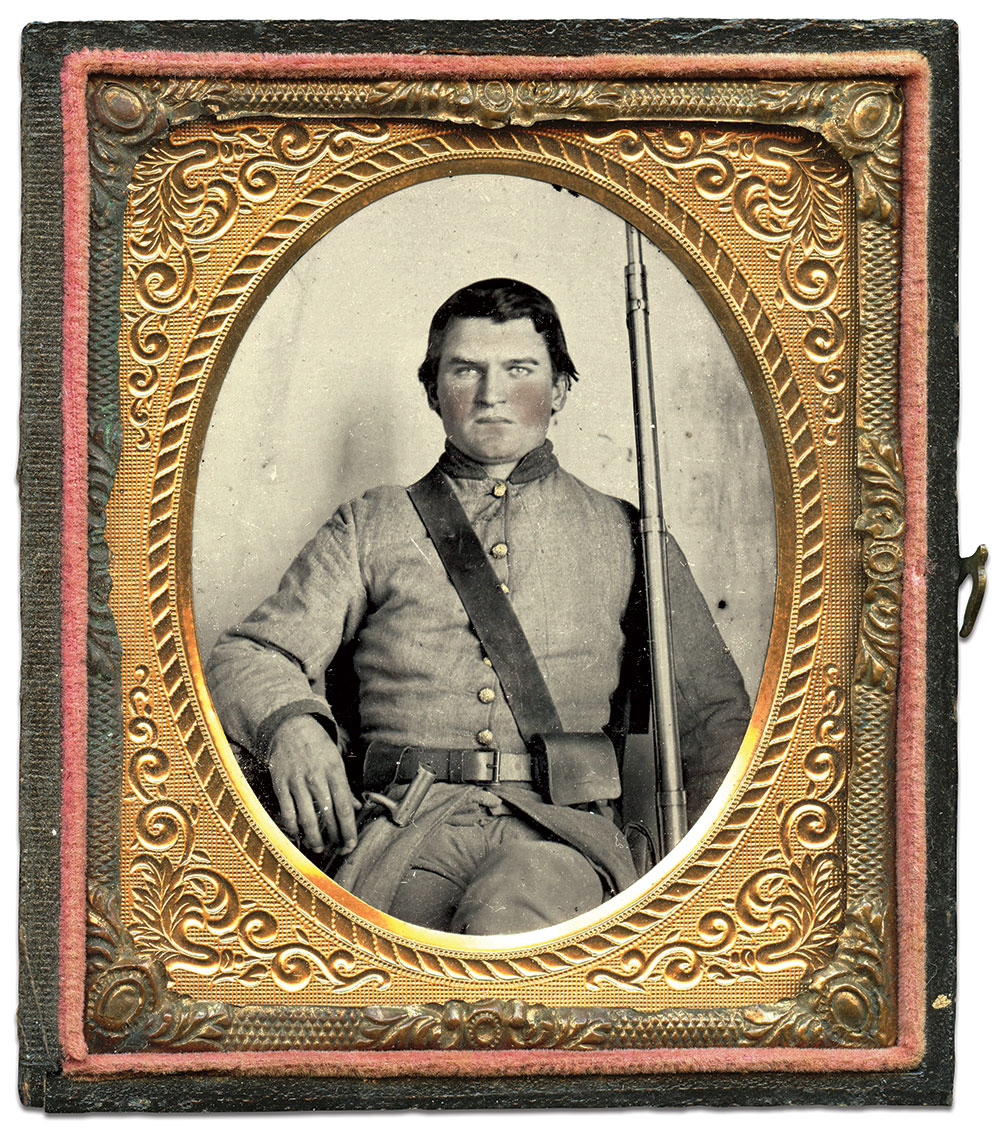
A clean-cut Confederate wearing a frock coat with dark cuffs and collar poses with a Model 1816/1822 musket, likely converted from flintlock to percussion. Though his home state is not known, chances are he may have hailed from Alabama, where this photograph was found.

A Southern corporal sat for this portrait with freshly issued, British-made military equipment imported by Confederates to supplement meager supplies. Visible is a snake buckle, shoulder strap and ball bag for ammunition. His cap is likely made of tarred canvas, though the finish resembles leather.

A Confederate soldier dressed in an elaborately trimmed jacket grips a rarely seen .28 caliber Warner pocket revolver. Patented by James Warner of Springfield, Mass., about 10,000 were produced and targeted for the civilian market before the war. Also of interest: the seven-point star insignia on the crown of his cap. Stars of the six- and seven-point variety were worn by soldiers from several Southern states, including Mississippi, where this soldier is believed to have enlisted.

Discovered in Mississippi, this infantryman has all the trappings of a volunteer from the state. He holds a conversion Model 1816/22 musket, with its bayonet attached to his waist belt.
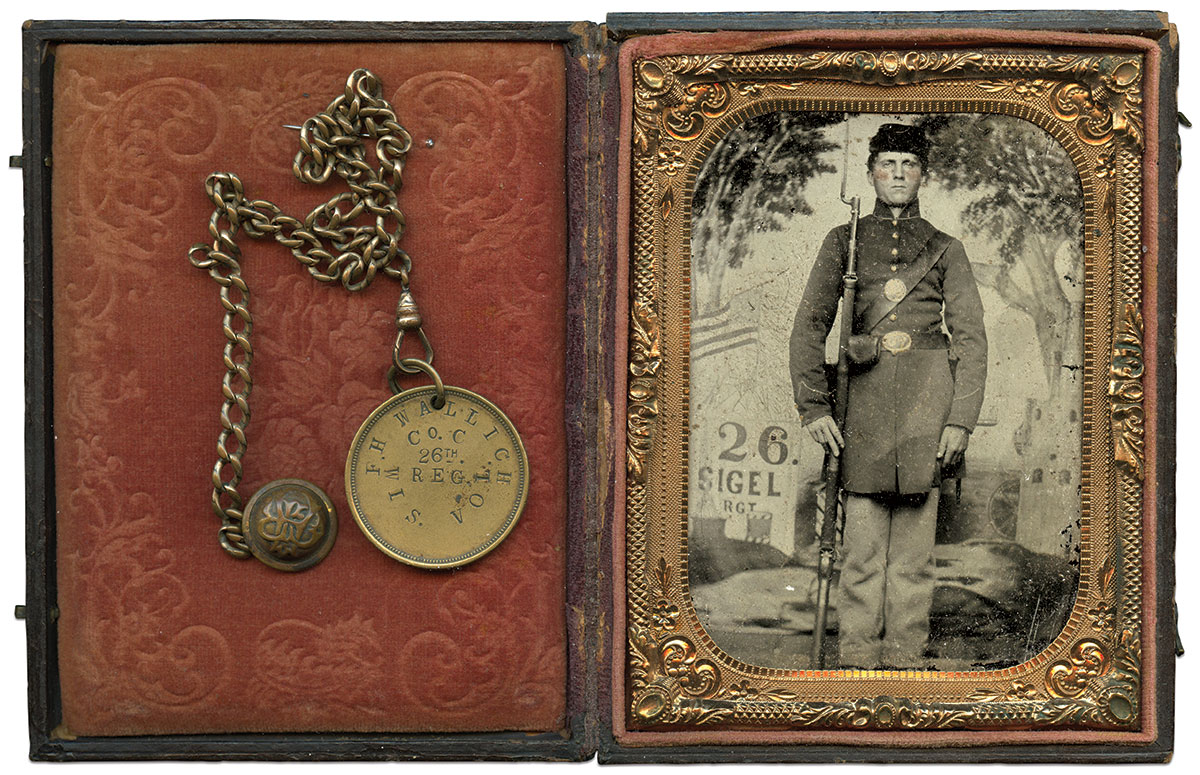
“I Goes to Fight Mit Sigel” was more than the title of a popular wartime song for Ferdinand H. Wallich, Jr. Born in Prussia, he came to America with his family at age 5 and settled in Milwaukee, Wis. In the summer of 1862, he enlisted in his state’s 26th Infantry, a regiment of predominantly German speakers that joined the Eleventh Corps, commanded by fellow German native Franz Sigel. The 26th, also known as the Sigel Regiment, is painted into the backdrop of this portrait, likely taken in Milwaukee. Also seen, his Pattern 1853 Enfield rifled-musket. Wallich served throughout the war. He survived the Battles of Chancellorsville, Gettysburg, and the campaigns of Atlanta, Savannah and the Carolinas. He returned to Wisconsin at the end of his enlistment and lived until 1913.

A mounted federal lieutenant or captain in full gear enjoys a smoke as he sits atop his well-accoutered mount. Of interest is the “Public Meeting” sign post on the wooden building in the background.

Sitting tall on his horse, William Root Brewster (1828-1869), left, has his hat with the diamond-shaped badge of the Third Corps pulled down low. A major in the 28th New York State Militia in the spring of 1861, Brewster helped New York politician and future Union major general Daniel Sickles raise recruits for what became the Excelsior Brigade. Brewster was rewarded for his efforts with the colonelcy of the 73rd New York Infantry. He led the Brigade at Gettysburg on July 2, 1863. In fighting near the Peach Orchard, rebels overran the Brigade, and shot Brewster’s horse from beneath him.
It is not known if the horse survived the battle, and, if so, if this is the same animal. Brewster survived Gettysburg and his war experience, mustering out in October 1864 during the Petersburg Campaign. Two months later, he received the brevet rank of brigadier general for his service, which he accepted in January 1865. He wears a brigadier’s uniform here, which suggests he posed for this portrait at some point after his acceptance. The heavy foliage on the trees behind him suggests it was made in the spring or summer.
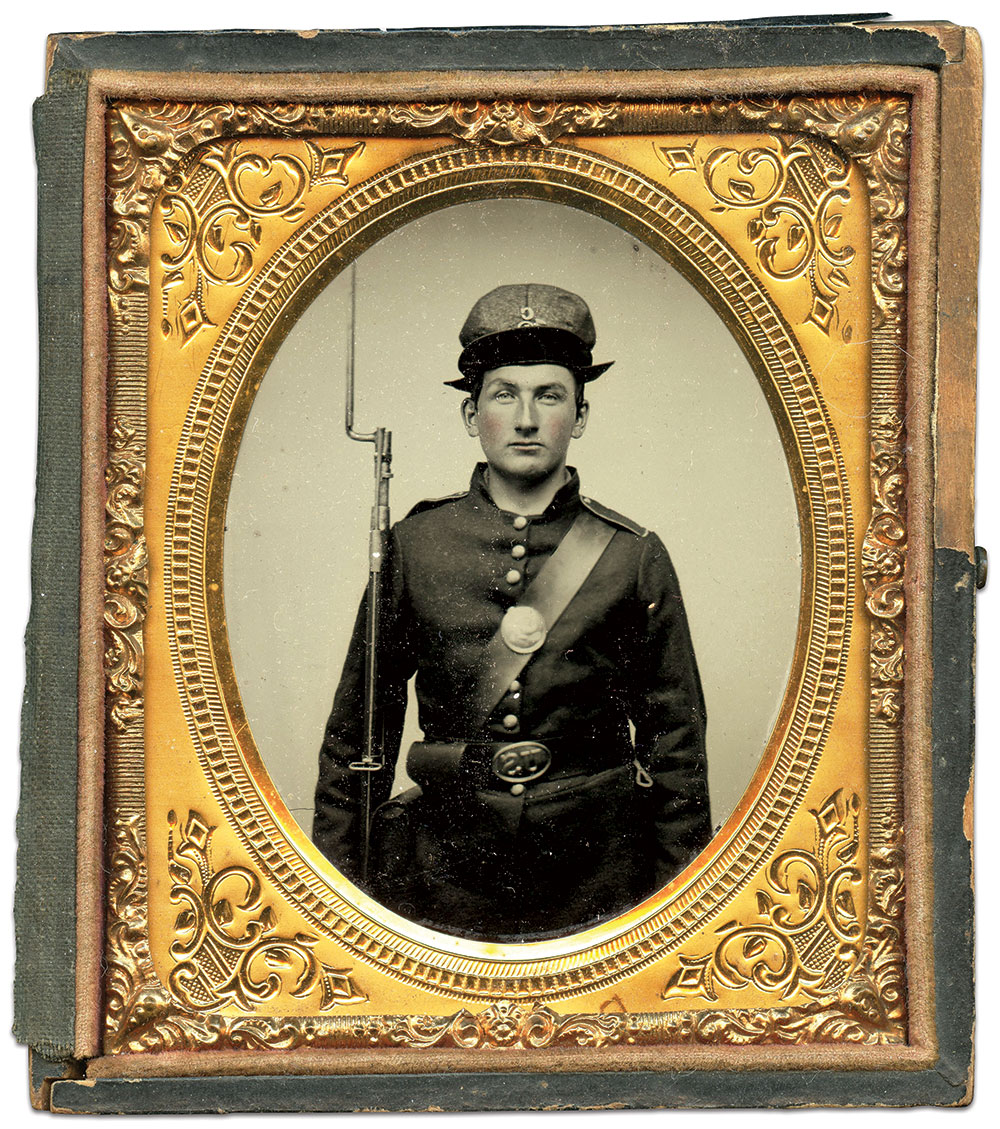
The love-hate relationship between Union soldiers and the experimental Havelock hats was the stuff of early war legend. Soldiers found them comfortable, but did not care for the look. We do not know how this soldier in Company C of the 5th New Hampshire, armed with a Model 1842 musket, felt about his Purinton and Ham hat. In the end, the Havelock hats were discarded in favor of standard flat-topped caps.

The contents of the field desk located inside a canvas tent are the focal point in this portrait of a Union officer and three enlisted men.
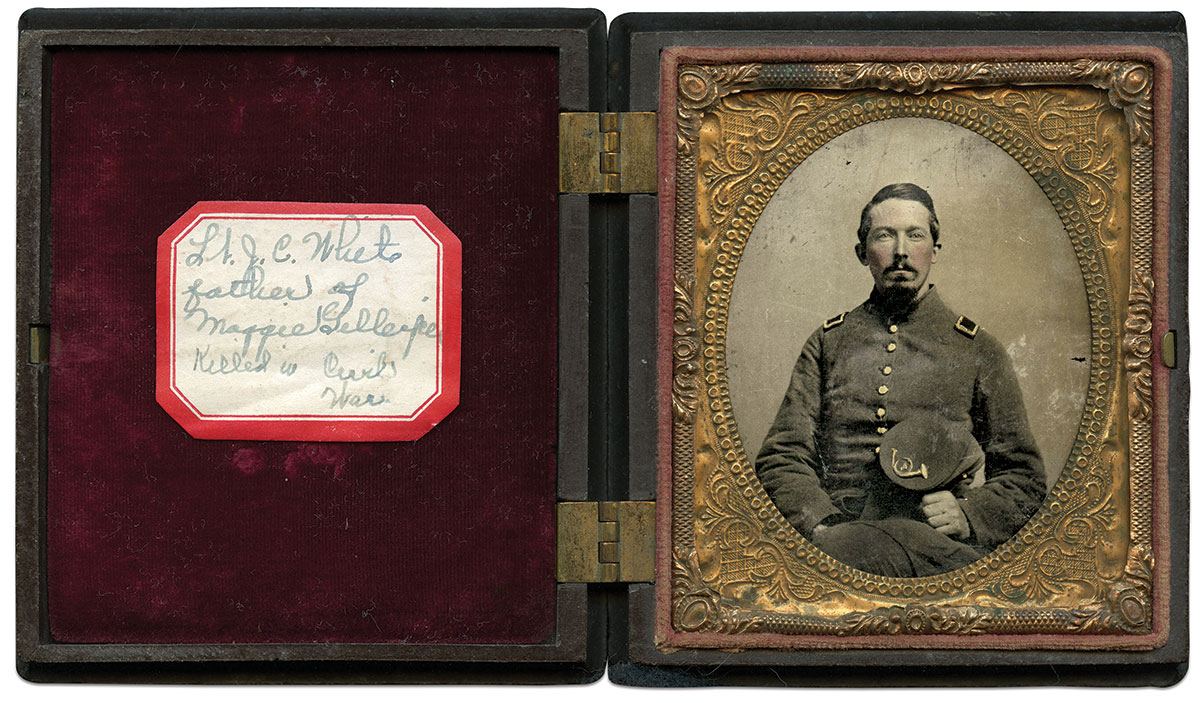
There came a moment during the Battle of Seven Pines on May 31, 1862, when the 4th North Carolina Infantry charged across a field through a hail of fire. The objective was to take heavily fortified Casey’s Redoubt, key to the Union position. It was accomplished at a high cost—almost half of the 678 North Carolinians became casualties, including 1st Lt. Joseph C. White.
The regiment’s official report recognized White and another officer, Capt. Jesse S. Barnes, for their heroism. “No braver men died that day than Captain Barnes of Company F, and Lieutenant White, of Company C, who were killed while leading their men up to the breastworks.”
A resident of Iredell County, White had joined the 4th a year earlier. The Yankee lead that struck him down cut short a promising career, and left in its wake grieving family and comrades.

The pair of Model 1863 Remington revolvers brandished by this boy soldier, right, appears larger than life, considering the trooper’s youth and small stature. His name and fate in the Union cavalry is currently lost in time.

At first glance, the headgear worn by this round-faced Union volunteer appears to be a civilian top hat. It is more likely a hat maker’s attempt to produce a regulation 1858 pattern dress hat. The revolver is a genuine Model 1851 Colt Navy.

This Confederate appears ready for fighting at close quarters with his pepperbox revolver and civilian single-shot pocket pistol. His skin appears sunburned, perhaps from the rigors of campaign, or diffused lighting and his darker complexion.

An early war volunteer is outfitted in the uniform of the Alabama Volunteer Corps, or A.V.C., as evidenced by his belt plate and dark uniform with red-trim and matching cap. He grasps a Model 1840 musician’s sword. Established by the state legislature in February 1860 as the nation inched closer to civil war, the A.V.C. was well established when hostilities began in April 1861.

James K. Herron of Somerville, Tenn., was by all accounts one of the state’s finest sons. Soon after the war started, the 20-year-old joined Capt. William M.R. Johns’ company of Tennessee volunteers, which became Company D of the 6th Tennessee Infantry. He posed here with a Model 1855 rifle or rifled musket. During the Battle of Shiloh on April 6, 1862, he suffered a mortal wound and succumbed on April 19. “He lived twelve days and suffered much,” reported the Memphis Daily Appeal. “He leaves a large family of relatives and many friends to mourn his untimely death, but such was his faith and deportment, that they enjoy the consolation that he yet lives.”
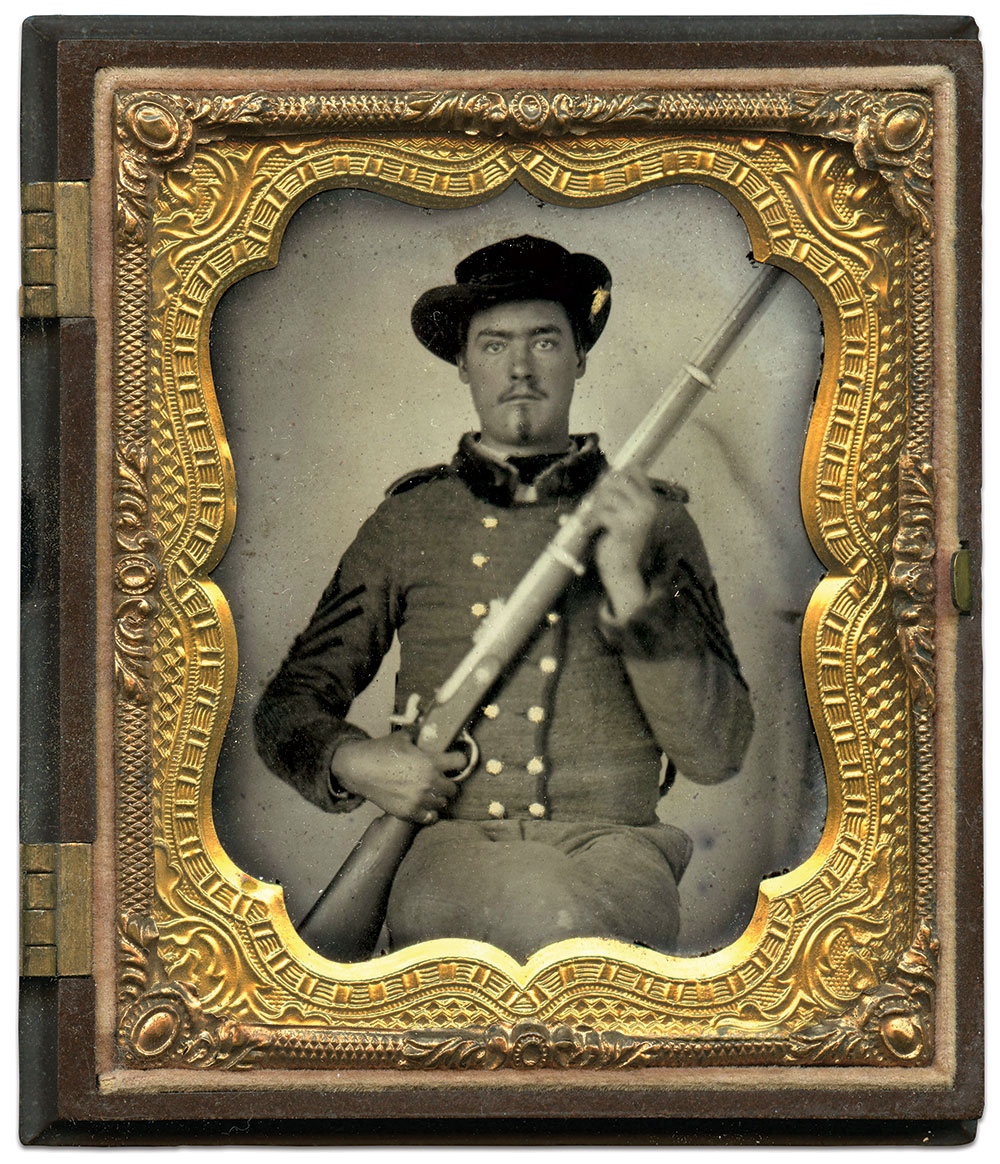
A Tar Heel first sergeant poses with his trusty Pattern 1853 Enfield rifled-musket. The double row of buttons on his trimmed coat are distinctive.

A federal cavalryman poses with the tools of his trade—a Smith carbine and a Model 1860 saber. His accouterments include a pistol cartridge box not often seen in Civil War images. This photograph was discovered in a Sidney, Neb., estate sale, which may offer a clue to the identity of this trooper.

Kentucky Pvt. Mat Miller wrote a few lines to his wife about various doings around camp in an undated letter tucked into the case holding his likeness. A private in the state’s Union loyal 4th Cavalry, he likely penned it in early 1864, an uneventful time spent near Chattanooga, Tenn. “Since we have been here you seam to think that I see a good deal of trobel but I have not seen it yet and I have never felt better in my life. I am as harty as a hog & one thinks that soldiering is damn hard work but they must fare wors than we do.”
But Miller’s health gave out, and he was sent to Nashville suffering from disease. He died on April 7, 1864.
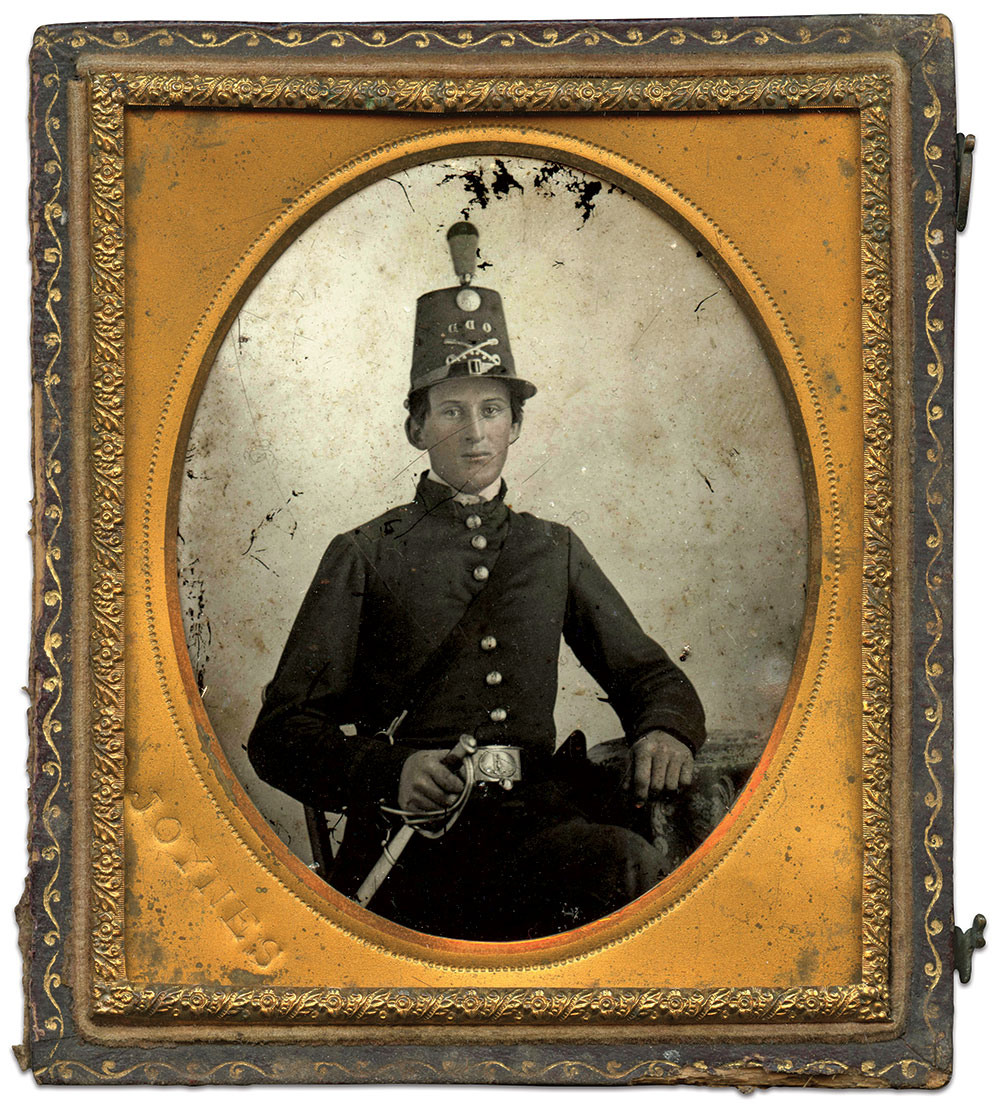
This trooper wears the dress uniform of Virginia’s Old Dominion Dragoons, which organized for service in April 1861 in Elizabeth City and Hampton. The volunteers became Company B of the 3rd Virginia Cavalry. A cache of these uniforms, tailored of dark blue satinet adorned with Virginia state seal buttons and distinctive shakos reminiscent of antebellum militias, fell into the hands of the 1st Vermont Infantry when it occupied Newport News in late May 1861. Eben K. Sanford, the regimental surgeon who established a post hospital in a private dwelling, noted in a letter, “I took summary possession of house and furniture, as well as kitchen, and a colored woman for cook; all of which we are ordered to hold and use for the benefit of the United States. I also made quite a haul of army ammunition, and uniforms, my predecessor being in fact an officer in a cavalry company, called the ‘Old Dominion Dragoons.’ I intend the uniforms shall do service on the Fourth of July in the Green Mountain state.”
Whether the uniforms made it to Vermont is unknown. The fate of the company and its service with the 3rd Virginia, however, is documented. It spent the bulk of its time in the Army of Northern Virginia and participated in major operations. The regiment numbered 210 sabers strong at the Battle of Gettysburg, and three men surrendered at Appomattox. Perhaps this trooper was one of the three that remained in the ranks at the war’s end.

The tiny pinfire revolver brandished by this Confederate was absolutely no match for the larger revolvers, muskets, rifles and carbines carried into battle. Perhaps it was a stand-in until the Southern government issued him his standard weapons. Still, he holds the gun with conviction. His plain jacket with flat and unadorned buttons make it difficult to identify his state of origin.

Two pards believed to hail from North Carolina posed for this portrait. Their dress suggests they served in different regiments. The gent on the left wears a red-trimmed light-colored uniform. His cap appears to bear both infantry and artillery insignia—the infantry horn in the center and crossed cannons below. The other individual is attired in civilian garb with the exception of his dark cap. Watson notes, “I have always loved this image because the guy on the right looks like the late Brian Pohanka who was one of my favorite Civil War historians.”
SPREAD THE WORD: We encourage you to share this story on social media and elsewhere to educate and raise awareness. If you wish to use any image on this page for another purpose, please request permission.
LEARN MORE about Military Images, America’s only magazine dedicated to showcasing, interpreting and preserving Civil War portrait photography.
VISIT OUR STORE to subscribe, renew a subscription, and more.

